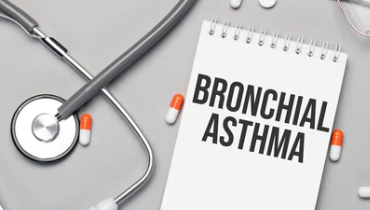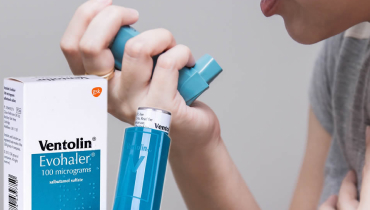Causes of bronchial asthma
Bronchial asthma (BA) is a chronic inflammation of the airways. The main signs of bronchial asthma are edema and spasm of the bronchi with attacks of suffocation, short inhalation and difficult exhalation. This leads to narrowing or overlapping of the airway lumen due to the contracting walls or the formation of mucous plugs in them.
Recently, the incidence of bronchial asthma, especially among children and adolescents, has been increasing all over the world. Pathology is increasingly leading to early disability, and the number of deaths is growing.
The mechanism of development of a spasmodic reaction of the bronchi is always an allergy. There are many reasons for its development:
- exogenous bioallergens – pollen, animal hair, specific food products;
- exogenous inorganic allergens – mineral dust, gases, vapors, combustion products;
- medical allergens – individual intolerance to certain drugs;
- physical allergens – too high humidity or, conversely, dry air, its high or low temperature;
- endogenous allergens – triggers of autoimmune reactions, which trigger the mechanism of pathologically increased spasm of the bronchial wall.
In addition, there are a number of factors of bronchial asthma that contribute to the development of the disease as a whole and the occurrence of individual attacks:
- hereditary predisposition, which is observed in one third of patients. If one of the parents is sick with BA, then the probability of this disease in a child is about 30%, and if both parents are sick, then more than 70%;
- bacterial or viral infections constantly present in the body;
- any violations of the immune system;
- bad habits, primarily smoking;
- work in an atmosphere contaminated with fine particles;
- life in poor environmental conditions;
- chronic malnutrition;
- uncontrolled intake of pharmacological drugs.
A person can get asthma regardless of age, but in more than half of cases, the first symptoms of bronchial asthma are observed in children under 10 years of age. This is due to the fact that before puberty, the child’s immune system is still physiologically immature, which means that the likelihood of failures in its work with the development of allergies is much higher. Very often the appearance of bronchial asthma is preceded by various infectious lesions of the respiratory tract, allergic rhinitis, conjunctivitis and cough.

Diagnostics of the bronchial asthma
The examination plan is developed by the attending physician individually for each patient, taking into account the recommendations received in consultation with an allergist, pulmonologist and ENT specialist.
Laboratory examinations are usually prescribed:
- clinical blood test, carried out every 10 days;
- blood chemistry;
- study of the concentration of glucose in the blood;
- tests for HIV, syphilis and hepatitis;
- general analysis of the discharge of the respiratory tract;
- its bacteriological culture;
- sowing of the obtained microflora for antibiotic resistance;
- general examination of urine.
A laboratory assessment of the functioning of the immune system is somewhat apart due to its increased importance in AD:
- skin allergy tests;
- study of the concentration of immunoglobulins A, M, and G in the blood serum;
- assessment of the content of total immunoglobulin E in the blood and its specific forms;
- assessment of the blood content of specific forms of IgG immunoglobulin;
- provocative allergy tests on the conjunctiva, nasal mucosa and respiratory tract;
- study of inhibition of natural migration of leukocytes.
Instrumental diagnostic methods are also widely used:
- X-ray of the chest and sinuses;
- electrocardiography;
- study of the function of external respiration with peak flowmetry.
- diagnostic bronchoscopy;
- tests for bronchial reactivity under the influence of various drugs and physical activity.
In addition, in recent years, the dependence of the severity of asthma on the presence of concomitant infections has been clearly proven. They can be caused both by ordinary bacterial lesions with a sluggish chronic course, and by more specific agents:
- chlamydia;
- mycoplasma;
- cytomegalovirus;
- Epstein-Barr virus;
- different strains of the herpes virus;
- fungi;
- helminths.
Therefore, in the diagnosis of asthma, special attention is paid to virological and bacterial examinations of various environments of the body (primarily sputum). It is also necessary to carry out the identification of parasitic infestations. Usually, for this, a study of feces for the presence of eggs of worms and blood for the presence of antibodies to helminths is used.
Treatment of bronchial asthma
To reduce the number of asthma attacks, it is critically necessary to limit, and ideally to exclude, the patient’s contact with the allergen, which gives rise to the onset of bronchospasm. For this you need:
- use air cleaners and air conditioners to ventilate the room and remove dust particles from its atmosphere;
- use humidifiers to combat excessive dryness;
- install climate control to maintain a stable, comfortable room temperature for the patient;
- destroy dust mites and cockroaches;
- put on hypoallergenic bed linen covers;
- abandon fleecy carpets;
- avoid contact with pets;
- choose a hypoallergenic diet.
Aerosol or tablets Ventolin with the active substance salbutamol – relief of symptoms of bronchial asthma when they occur; – prevention of attacks of bronchospasm associated with exposure to an allergen or caused by physical activity; – use as one of the components in long-term maintenance therapy of bronchial asthma.
Allergen-specific immunotherapy (ASIT) is an effective method of treating AD. The purpose of this method of therapy is to reduce the sensitivity of the patient’s immune system to a specific allergen. In fact, ASIT is a special type of long and slow vaccination, since the duration of one course can be up to 5 years.
Indications for using ASIT:
- the proven role of a certain allergen (household chemicals, pollen, wool) in the occurrence of exacerbations of bronchial asthma;
- inability for the patient to avoid contact with the substance-allergen;
- age up to 50 years.
Contraindications for the use of ASIT:
- period of exacerbation of the disease;
- very severe form of asthma;
- pregnancy;
- oncopathology, autoimmune disorders, infectious lesions in the acute phase, blood diseases.
Choose an allergen for ASIT and determine the duration of treatment should only be an allergist. The essence of the procedure is that microdoses of the allergen or their mixtures are administered to the patient according to previously developed schemes. For bronchial asthma, in adults, subcutaneous injections are used, in children – drops under the tongue. Over time, the dosage and concentration of the allergen increase. Due to this, the immune system gradually gets used to its presence in the body and the severity of the allergic reaction to it, including the reaction of the bronchi, slowly decreases until it disappears completely.
With the help of ASIT, it is possible to reduce the number of attacks and the amount of medications taken, prevent the transition of the disease to a more serious stage, and even cause its stable remission. To achieve optimal results with ASIT will help:
- early initiation of therapy, best of all – when the first signs of asthma are detected;
- destruction of all foci of infection in the body;
- antihelminthic treatment;
- correction of the immune status.

Medication therapy for bronchial asthma is divided into:
- basic, which is used constantly to control the disease (cromones, oral and inhaled glucocorticosteroids, antileukotriene drugs and monoclonal antibodies);
- symptomatic, designed to combat seizures (drugs that relieve spasm of smooth muscles of the bronchi – β2-adrenomimetics and xanthines).
In addition to pharmaceuticals, ASIT and other methods of treatment for bronchial asthma, the behavior of the patient himself is extremely important. It is on him that the success of therapy and the likelihood of achieving a stable remission of the disease largely depend. To get the most positive result, the patient must strictly follow several rules:
- Engage in self-education regarding bronchial asthma. In doing so, use only reliable sources: get information from your doctor, from reliable popular scientific medical literature.
- Sign up for classes in an asthma school in your city or in the same virtual community. Take advantage of the advice you receive there and change your lifestyle, environment and decor in accordance with them.
- Under no circumstances change the treatment regimens prescribed by your doctor on your own. Strictly follow his recommendations.
- Come to the appointment not only for routine examination, but also for exacerbations of asthma.
- Monitor the state of your body on a daily basis, both subjectively and using objective parameters, for example, the results of peak flowmetry.












I have received my package. thank you. Will use my discount for further orders! Thanks.
I have received my package and it is in fine condition. Thanks.
Hi i have received my package. Thank you!